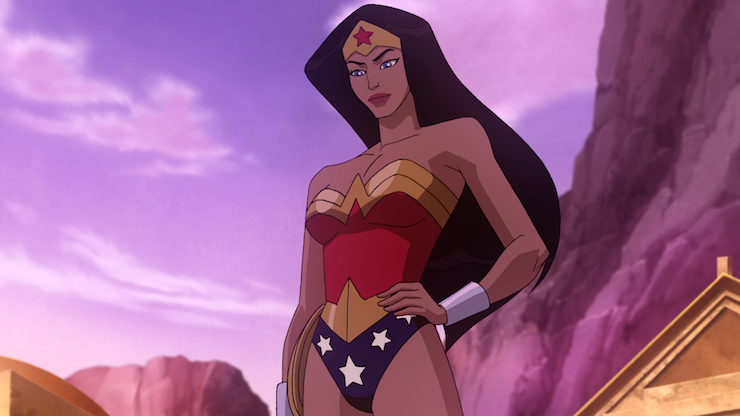Wonder Woman has a much lengthier career in animation than live-action. Despite this, the 2009 animated Wonder Woman is her only solo title.
Bizarrely, Wonder Woman’s first appearance in animation was in, of all things, a 1972 episode of The Brady Kids, an animated spinoff of The Brady Bunch. But she truly came into her own as an animated star in the various Super Friends cartoon series of the 1970s and 1980s, which featured Superman, Batman, Wonder Woman, and Aquaman, among others. Shannon Farnon, Connie Caulfied, and B.J. Ward all voiced Wonder Woman at various points.
Wonder Woman was also a main character in the Justice League and Justice League Unlimited animated series that spun off of Batman: The Animated Series and Superman: The Animated Series in the 1990s. Susan Eisenberg provided the character’s voice throughout.
Wonder Woman has appeared in several of DC’s direct-to-DVD movies and assorted other TV shows as a supporting character, mostly as a member of the Justice League, voiced by a variety of folks: Laura Bailey, Rosario Dawson, Grey DeLisle, Eisenberg, Rachel Kimsey, Lucy Lawless, Vanessa Marshall, Michelle Monaghan, Maggie Q, Cobie Smulders, Kari Wahlgren—and Keri Russell, who voiced her in her 2009 solo release.
Wonder Woman has gone through many incarnations over the decades, but one of the most popular versions was the post-Crisis on Infinite Earths reboot masterminded by George Pérez, with help from Greg Potter and Len Wein, in the mid-1980s. Pérez brought Diana back to her Greek mythological roots and set her up as an emissary from Paradise Island. Pretty much every incarnation of Wonder Woman in print and onscreen that has been done since then has taken at least some cues from this iteration of Diana, generally to good effect.
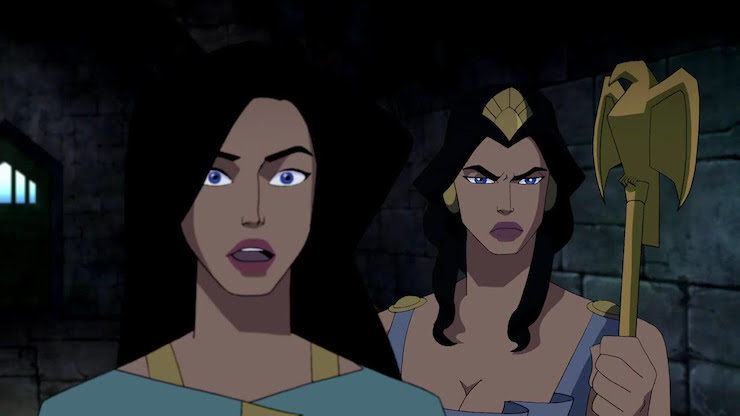
The 2009 film, which stars the voices of Russell as Diana and Nathan Fillion as Steve Trevor, is a partial adaptation of Pérez’s work from the 1980s, though it brings in elements from several versions of the character. The story is by Gail Simone, herself an accomplished comics writer who wrote Wonder Woman for two and a half years, and Michael Jelenic, one of the regular writers of DC animated films and TV series (including the recent Batman: Return of the Caped Crusaders), with Jelenic writing the script.
I just wish it was stronger than it actually was. I found myself annoyed by this movie a lot more than I wasn’t.
For starters, while Andrea Romano remains the greatest casting director in the history of animation (to this day, many of her vocal castings have remained iconic, most notably Kevin Conroy as Batman and Mark Hamill as the Joker), she doesn’t quite hit the mark with the stars here. Russell does nothing to make Diana stand out. Her line readings are adequate, but nothing more. Ditto for Alfred Molina, who exudes surprisingly little menace as Ares. As for Fillion, the problem here is that he’s not playing Steve Trevor, he’s playing Nathan Fillion. It’s Richard Castle if he was an Air Force pilot, which does result in some very funny lines, at least. (“While the Amazons have the truth lasso, I have tequila.”) Fillion at least manages to imbue his character with personality, which is more than Russell or Molina can manage. But it still feels like he wandered in from another franchise.
The supporting cast fares much better. Dawson gives Artemis some serious attitude, Virginia Madsen imbues Hippolyta with regal grace, and Oliver Platt is superb as Hades—though it’s unclear as to why, exactly, they chose to animate him as obese.
The original cut of the film that was submitted for an MPAA rating was much bloodier, but it was given an R. As a result, it was reanimated to get rid of most of the blood. So the opening scene, in which the Amazons fight Ares’s forces, and the climactic battle across Washington, D.C. has lots of people being stabbed and beheaded and not a single drop of blood. Diana has blood trickling out of her mouth a couple of times, and Alexa’s mouth is filled with blood when Persephone stabs her. But that’s it, and it results in some really bizarre, bloodless violence.
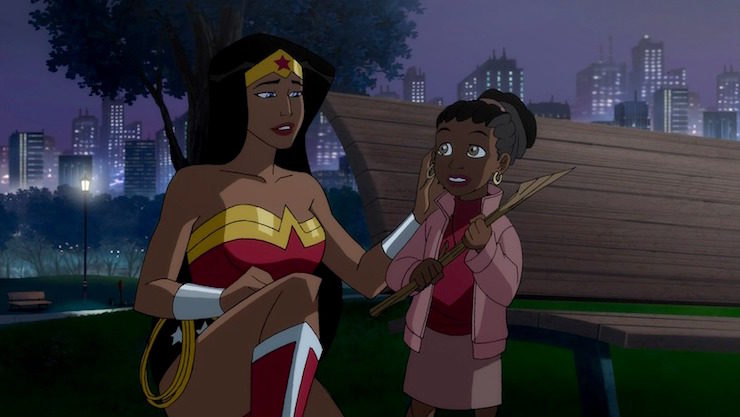
The movie has its moments. I like the character of Alexa, and I especially like that her love of reading is one of the things that saves the day. I like that Trevor’s attempt to get Diana drunk is such an abject failure. I love Diana using her indestructible lasso as a shield to stop Ares’s sword. (I don’t think the lasso has ever been used that way before, and it’s brilliant.)
And the whole movie’s worth it for the scene in the park. Diana sees a little girl crying near some boys playing with swords. The girl reveals that the boys won’t let her play pirate with them because she can’t wield a sword. Diana tartly points out that the boys can’t, either, and then gives the girl some tips using a stick. With Diana’s urging to “Go, raise hell,” the girl immediately runs in and starts waving the stick around, scaring the crap out of the boys. (It also leads to another of Fillion’s funny lines, to wit, “That is sweet—teaching her to disembowel her playmates like that.”)
The movie starts with the aforementioned battle between Ares’s forces and the Amazons, led by Hippolyta. The Amazons are victorious, and Hera grants them their own island of Themyscira, where they will live alone in peace, away from the rest of the world. They also get Ares as a prisoner, and he wears gauntlets that prevent him from accruing power via the fighting of wars. Hera also grants Hippolyta a child made from the sand of the beaches of Themyscira, whom she names Diana.
Centuries later, three Air Force pilots get into a dogfight over Themyscira. The island is hidden from view except when someone touches the mirror that Hippolyta uses to view the outside world. The air battle only has one survivor: Steve Trevor, who sees the island when Hippolyta punches the mirror, and he crash lands. He’s taken prisoner and interrogated with the lasso of truth, which makes it clear that his crashing there was an accident. A martial contest is held to see who will be the Amazons’ emissary to escort Trevor back to the outside world. Diana enters in secret, against Hippolyta’s wishes, and wins.
Unfortunately, Ares has been playing a long game, seducing Persephone—who was blinded in one eye in the final battle with Ares and who has served as his main guard all these centuries—who kills Alexa and frees the god of war.
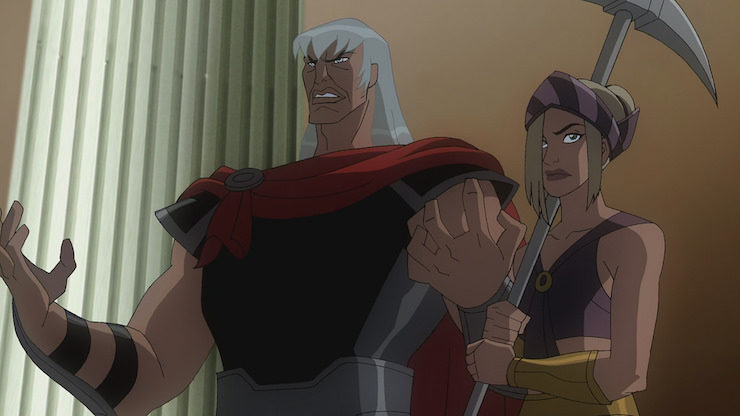
Diana’s mission is now twofold: return Trevor to his people and stop Ares. Trevor helps with the latter, using Air Force computers to track heightened violent activity that follows Ares around. They are unable to stop Ares from opening the gates to Hades, and after the god of war gets his uncle, the god of the underworld, to release him from the gauntlets, he’s free to cause havoc.
Ares and his forces gather in Washington, D.C. Diana and Trevor try to stop him, soon backed up by the Amazons, who storm the city via the Potomac. (U.S. armed forces are curiously absent throughout all of this. In fact, the only action taken by the U.S. government is to send a handful of soldiers who are dispatched early on, and they also fire a missile at Themyscira, that Trevor stops with help from the invisible jet.) Diana manages to snatch Ares with her lasso right when he’s about to rain lightning down on her, nabbing him and switching places with him so he’s hit with the lightning, then she beheads him.
All the usual beats of a Wonder Woman origin story are hit here, and it feels depressingly perfunctory, if not downright lazy. And the story has tons of head-scratchers. What were Steve and his two buddies doing, anyhow? Who was it who shot at them? If Trevor was believed killed, why did he spend all his time after returning home hanging out with Diana instead of, y’know, reporting to his superiors like he’s supposed to and letting them know he’s alive?
Worse, though, is that the movie defaults to tired gender roles, and half the time it feels like it was released in 1969 instead of 2009.
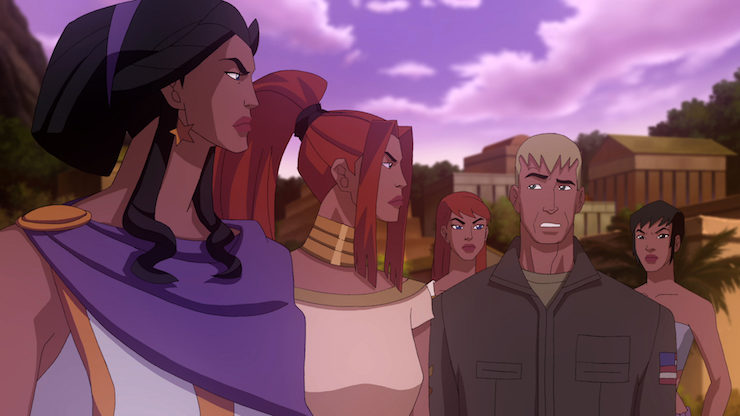
We start with Trevor crashing on Themyscira, and what’s the first thing he sees? A bunch of Amazons cavorting naked under a waterfall—because what better touchstone for a Wonder Woman movie than a scene out of a Russ Meyer movie? The character of Etta Candy—long an important supporting character and good friend of Diana’s going back to the 1940s—is reinterpreted here as a blonde who plays helpless and needy in order to flirt with Trevor in her one and only scene, quite possibly the most appalling use of the character in her 75-year history. Later on, when they’re trying to stop Ares from opening the gate to Hades, Diana is snagged by a harpy, and Trevor saves her by throwing a grenade down the harpy’s throat.
As soon as that happened, I practically screamed at the movie. Trevor saves Diana? No. I have no problem with him holding his own, but the ordinary pilot saving the life of the super-strong Amazon? That wouldn’t even happen if the gender roles were reversed.
Worse, when she’s recovering in the hospital—and how did that happen, anyhow? he’s still legally dead and she has no identity outside Themyscira—he claims he saved her because of the feelings he’s developed for her, and I’m sorry, but there hasn’t been time for that to have happened. Just in case we’ve forgotten that, he himself points out that she’s only known men for fifteen minutes, so she shouldn’t judge all men as being bastards based on that—but that’s how long he’s known her, and he’s already crazy in love with her? Sure…
Not only that, but that entire scene was a missed opportunity to actually remember that Trevor just lost two people close to him. The other two pilots’ deaths affected him greatly while the battle was happening, but they’re never even mentioned again once he lands on Themyscira. That hospital scene was a great opportunity for some actual character development of Trevor—establish that he saved Diana because he couldn’t save the other two pilots, and he couldn’t face losing someone else in battle like that.
But no, instead it’s an opportunity for a #notallmen rant about how he’s just holding doors open for women because he’s polite (seriously?), followed by a declaration of true love.
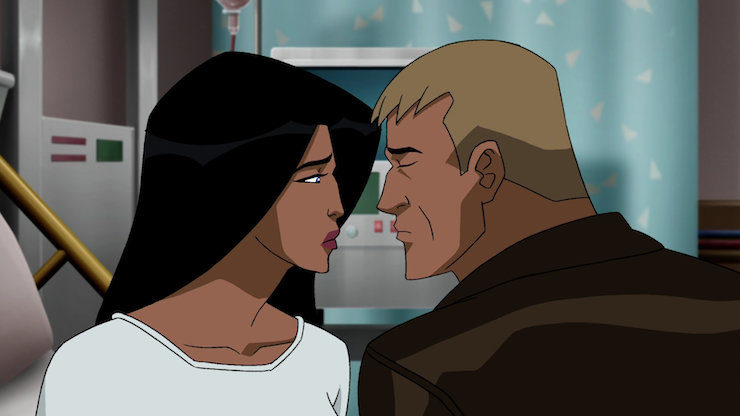
Trevor is portrayed as a womanizer and a flirt and something of an ass. (He admits to all that in a hilarious confession in the invisible jet before he belatedly realizes that his foot is looped in the lasso.) That’s fine as far as it goes, but he’s rewarded for this behavior by getting a kiss from Diana at the end and apparently after Hippolyta sends Diana back to the outside world to be a permanent ambassador, they’re living together. And I’m just wondering why. I mean, I get what he sees in her, but I haven’t the foggiest idea what she sees in him. He’s a jerk who acts like a jerk the entire time they’re together. Yes, he’s helpful in her fight against Ares, but in the end the only real reason they kiss is because that’s how it’s supposed to be in movies. It’s the laziest of lazy writing.
There’s more. Persephone goes with Ares because by following Hippolyta she has been denied her ability to have a family and children. Her dying words are to remind Hippolyta that, while the Amazons are warriors, they’re also women, too. Because, of course, that’s all women are good for, is bearing children and being subservient to their men, right? (And that’s not extrapolating—Persephone refers to Ares, with whom she has explicitly said she has fallen in love, as “my king” and is completely subservient to him. Yeah, he’s a god and she’s an Amazon, but she betrayed her people for this…) Hippolyta’s response to this comment from Persephone is to look pained and regretful, like she never thought of that before. And why the hell should she have?
In William Moulton Marston’s original comics, all the Amazons wore bracelets as a reminder of when they were enslaved by men. In this movie, that never comes up; instead, the only person besides Diana who wears bracelets is, of all people, Ares. Instead of being a reminder of women’s oppression, the bracelets are now just another tool, used by Diana to deflect bullets and by the Amazons to imprison Ares.
And then, when Diana confronts Ares at the Lincoln Memorial Reflecting Pool, her crowning-moment-of-awesome dialogue before she kicks his ass? “I have learned one thing—it’s not polite to hit a lady.”
Aaaaaaaaaaaaand I throw my shoe at the screen. That’s the sort of “clever” line I’d expect from Yvonne Craig’s Batgirl, not a 21st-century interpretation of a superhero. We’re supposed to cheer at this snarky callback to a patronizing faux-truism of the 20th century? Particularly in a movie in which women have been portrayed as powerful warriors?
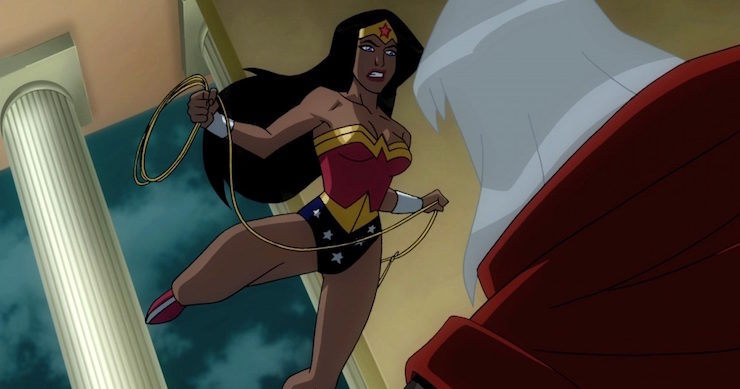
The subplot with Artemis the warrior and Alexa the bookworm is decent. Artemis trying to actually read a book to honor Alexa at the end is adorable. And in general, Dawson does a fine job with Artemis—so much so you that you wish Romano had just let her play Diana. (She would rectify this later, as Dawson provides Wonder Woman’s voice in Justice League: Throne of Atlantis, Justice League vs. Teen Titans, and Justice League Dark.)
This is a perfectly serviceable Wonder Woman story, but it’s done in by some questionable choices. Ones I really hope that Zack Snyder, Allan Heinberg, Jason Fuchs, and Patty Jenkins were able to avoid when putting together the character’s first-ever live-action theatrical release.
Keith R.A. DeCandido also took a look at the Lynda Carter Wonder Woman TV series and is really looking forward to the Gal Gadot film. He’s been writing about Star Trek, Stargate, Batman 66, Doctor Who, and Marvel’s Netflix series for Tor.com since 2011, and will soon embark on an overview of comic book superheroes adapted into live-action movies (the Cathy Lee Crosby 1974 Wonder Woman movie among them). He’s also an award-winning best-selling author of more than fifty novels, among the most recent of which is a novel trilogy called Marvel’s Tales of Asgard, starring another superhero with mythological roots, Thor (as well as Sif and the Warriors Three), on sale now from Joe Books.










